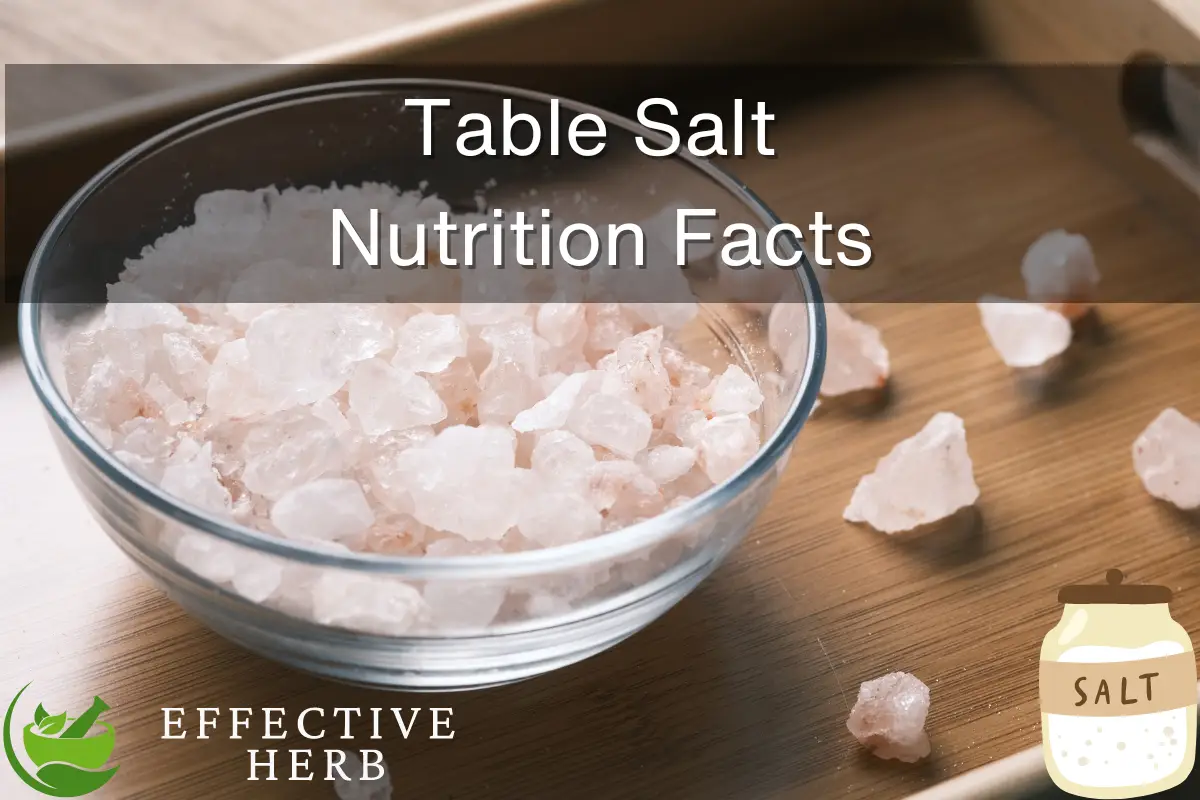Salt, Table Nutrition Facts
Delve into the nutrient facts for table salt, a common seasoning used to enhance the flavor of various dishes.
Full Nutrient Table
Below values are based on a 100-gram portion.
| Name | amount | Unit |
|---|---|---|
| Proximates | ||
| Water | 0.2 | g |
| Energy | 0 | kcal |
| Energy | 0 | kJ |
| Protein | 0 | g |
| Total lipid (fat) | 0 | g |
| Ash | 99.8 | g |
| Carbohydrates | ||
| Carbohydrate, by difference | 0 | g |
| Fiber, total dietary | 0 | g |
| Sugars, total including NLEA | 0 | g |
| Minerals | ||
| Calcium, Ca | 24 | mg |
| Iron, Fe | 0.33 | mg |
| Magnesium, Mg | 1 | mg |
| Phosphorus, P | 0 | mg |
| Potassium, K | 8 | mg |
| Sodium, Na | 38800 | mg |
| Zinc, Zn | 0.1 | mg |
| Copper, Cu | 0.03 | mg |
| Manganese, Mn | 0.1 | mg |
| Selenium, Se | 0.1 | µg |
| Fluoride, F | 2 | µg |
| Vitamins and Other Components | ||
| Vitamin C, total ascorbic acid | 0 | mg |
| Thiamin | 0 | mg |
| Riboflavin | 0 | mg |
| Niacin | 0 | mg |
| Pantothenic acid | 0 | mg |
| Vitamin B-6 | 0 | mg |
| Folate, total | 0 | µg |
| Folic acid | 0 | µg |
| Folate, food | 0 | µg |
| Folate, DFE | 0 | µg |
| Choline, total | 0 | mg |
| Vitamin B-12 | 0 | µg |
| Vitamin B-12, added | 0 | µg |
| Vitamin A, RAE | 0 | µg |
| Retinol | 0 | µg |
| Carotene, beta | 0 | µg |
| Carotene, alpha | 0 | µg |
| Cryptoxanthin, beta | 0 | µg |
| Vitamin A, IU | 0 | IU |
| Lycopene | 0 | µg |
| Lutein + zeaxanthin | 0 | µg |
| Vitamin E (alpha-tocopherol) | 0 | mg |
| Vitamin E, added | 0 | mg |
| Vitamin D (D2 + D3), International Units | 0 | IU |
| Vitamin D (D2 + D3) | 0 | µg |
| Vitamin K (phylloquinone) | 0 | µg |
| Lipids | ||
| Fatty acids, total saturated | 0 | g |
| SFA 4:0 | 0 | g |
| SFA 6:0 | 0 | g |
| SFA 8:0 | 0 | g |
| SFA 10:0 | 0 | g |
| SFA 12:0 | 0 | g |
| SFA 14:0 | 0 | g |
| SFA 16:0 | 0 | g |
| SFA 18:0 | 0 | g |
| Fatty acids, total monounsaturated | 0 | g |
| MUFA 16:1 | 0 | g |
| MUFA 18:1 | 0 | g |
| MUFA 20:1 | 0 | g |
| MUFA 22:1 | 0 | g |
| Fatty acids, total polyunsaturated | 0 | g |
| PUFA 18:2 | 0 | g |
| PUFA 18:3 | 0 | g |
| PUFA 18:4 | 0 | g |
| PUFA 20:4 | 0 | g |
| PUFA 2:5 n-3 (EPA) | 0 | g |
| PUFA 22:5 n-3 (DPA) | 0 | g |
| PUFA 22:6 n-3 (DHA) | 0 | g |
| Fatty acids, total trans | 0 | g |
| Cholesterol | 0 | mg |
| Phytosterols | 0 | mg |
| Amino acids | ||
| Tryptophan | 0 | g |
| Threonine | 0 | g |
| Isoleucine | 0 | g |
| Leucine | 0 | g |
| Lysine | 0 | g |
| Methionine | 0 | g |
| Cystine | 0 | g |
| Phenylalanine | 0 | g |
| Tyrosine | 0 | g |
| Valine | 0 | g |
| Arginine | 0 | g |
| Histidine | 0 | g |
| Alanine | 0 | g |
| Aspartic acid | 0 | g |
| Glutamic acid | 0 | g |
| Glycine | 0 | g |
| Proline | 0 | g |
| Serine | 0 | g |
| Alcohol, ethyl | 0 | g |
| Caffeine | 0 | mg |
| Theobromine | 0 | mg |
| Name | amount | Unit |
Nutritional Charts for Salt, table
Nutrient Composition Pie Chart
This chart shows the proportion of different macronutrients (protein, fat, carbohydrate) and micronutrients (vitamins and minerals) in the food.
Conclusion
In conclusion, while salt is an essential part of the diet, moderation is key to preventing health issues. Understanding the chemical composition of salt, its health effects, and how to reduce intake can aid in achieving a balanced diet. For more detailed nutrient information, see the Source.
